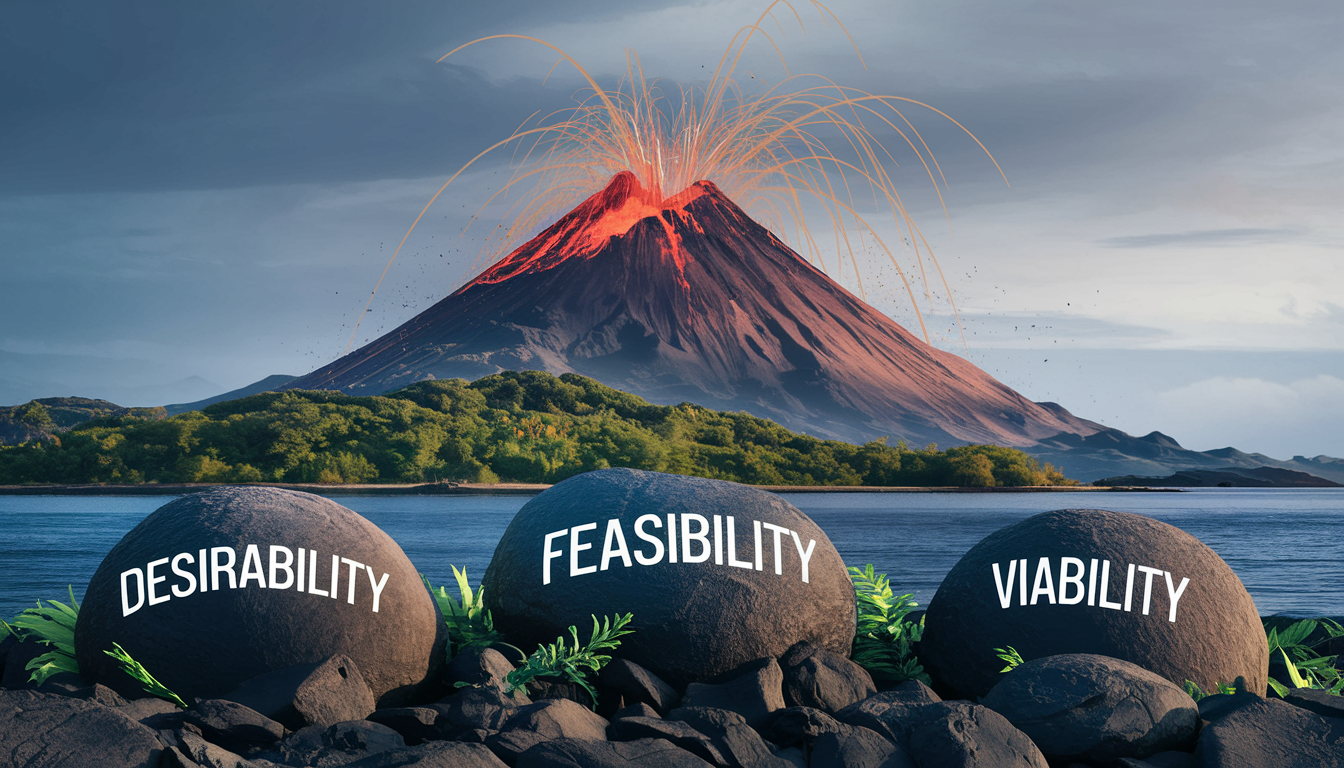Why do some products soar while others flop, despite great ideas behind them? The secret often lies in three deceptively simple words: desirability, feasibility, and viability. IDEO popularized these design thinking pillars in the early 2000s. They spark creativity and ensure your product works and sells.
In this article, we’ll explain what each term means in practice and why it matters in today’s market. You’ll also see how companies use them to design smarter, sustainable products. Additionally, you’ll discover real-world examples, practical tips, and the one mistake many teams make when balancing these three forces.
Curious to know which factor businesses often over-prioritize? Or how can you apply this framework beyond product design? Keep reading till the end — we’ve got insights that can reshape how you approach your next big idea.
Understanding Design Thinking Principles
Design Thinking is a way to solve problems by focusing on the user. It aims to understand what users need and create solutions that meet those needs in a new and lasting way. At the heart of this method are three key principles: desirability, feasibility, and viability. These principles, developed by IDEO in the early 2000s, keep the design process grounded in real market needs.
User-centered design is key in Design Thinking. It puts the user at the center of the design process. This ensures that products and services solve real user problems. It also boosts user satisfaction and keeps users coming back.
The problem-solving strategy in Design Thinking involves making, testing, and improving solutions in a loop. This loop lets companies test key features early, get feedback from users, and refine their solutions before launching. Using a Minimum Viable Product (MVP) can cut costs by 30-50%, making the project more feasible.
When companies check their ideas against desirability, feasibility, and viability, they’re more likely to meet market needs. Viability tests make sure the business model fits with what users want to pay for and use. This balance is crucial for success in the long run.
Understanding these principles helps create products that are not just good but also sustainable and profitable. This ensures they meet market needs and succeed in a competitive world.

Exploring Desirability in Design
Understanding product desirability is key to making successful products. Sadly, 70% to 80% of new products fail early on. This is often because they don’t meet consumer needs or stand out from others.
A focus on making products desirable can help. It ensures the product meets and exceeds user expectations.
Empathy in design is vital for customer satisfaction. Designers who empathize with users create products that truly connect with them. Tools like empathy maps help designers understand and address user pain points.
This approach not only improves the user experience but also makes products more desirable.
User needs analysis is crucial for evaluating desirability. Designers use direct feedback, usability testing, and research to understand user expectations. This helps prioritize ideas and develop a product that meets user goals.
The DVF framework helps filter out ideas that won’t work. By focusing on user demands, designers save time and increase the product’s chances of success. A deep focus on user experience and empathy leads to a product that delivers value and satisfaction.
Assessing Feasibility: Making Ideas Work
Feasibility in design checks if a project fits within current capabilities and technical limits. First, teams need to plan out resources well. This ensures they have the right tech, materials, skills, and money for new ideas.
Technical assessment is also crucial. It looks at the tech needs and finds problems early. This ensures that people can actually implement new ideas. Companies that do this well can overcome challenges and find efficient ways to solve problems.
Feasibility analysis also looks at what a team can do. Knowing these limits helps plan projects better. For example, good planning and communication can cut down on project delays. This is important because about 60% of new products don’t make money.
Having skilled teams is also important. They can make products faster using current tech. This shows how picking the right team is key to keeping projects on track and within budget.
Making sure ideas are both new and doable means always checking feasibility. When teams do this well, they focus on what’s most valuable. This approach leads to growth, with businesses seeing a 30% increase in success.
Viability: Ensuring Business Success
Ensuring business success means checking if ideas can work in the market. This involves looking at trends, competitors, and how money will flow. It’s about making sure the business can keep going.
Checking if an idea is viable means looking at money and market research. A good study can help pick the best ideas. It looks at money, organization, laws, operations, and resources.
Keeping investors interested is key, even when things get tough. Good user flows make things easier and happier for users. This helps businesses stay strong over time.
A business needs a solid plan and team to succeed. The team’s skills are very important. Market research helps set prices and see if there’s demand.
It’s also smart to think about different scenarios. This way, businesses can handle any situation. Understanding user flows helps make digital products better and avoid mistakes.

The Interconnection of Desirability, Feasibility, and Viability
Desirability, feasibility, and viability form the “triple constraint” of an integrated design process. This approach makes sure a product is appealing, easy to make, and can succeed in the market. This connection leads to better results for both businesses and customers.
A product that people want but that doesn’t make money won’t survive. On the other hand, a product that’s profitable but not wanted might make money, but it can’t keep the business going. Knowing what the market wants is key to making a product that’s both wanted and can make money. Also, a product must be possible to make to meet user needs and market demand.
It’s important to balance desirability, viability, and feasibility for a product to succeed. But, sometimes you have to make choices between these. Getting feedback from the market is crucial to see if a product can make money and meet user needs. For example, improving a product design and development through testing helps find a good balance.The framework of desirability, viability, and feasibility helps businesses decide on new ideas and how to use resources. By using this design process, companies can create products that users love and help the business grow. For more on improving user experiences and design, check out the user flow guide.
Conducting User Research To Drive Design
User research is key to making designs work. A good UX research plan is vital. It helps collect user data and involves stakeholders. Without it, designs might not meet user needs.
Collecting user data and analyzing feedback helps understand what users want. Surveys, interviews, and usability tests give insights into user behavior. These methods help shape designs at every step.
UX research is not just for the start of a project. It’s ongoing, with tests and feedback after launch. This keeps designs in line with what users need. There are many ways to research, like talking to users and A/B testing.
A good UX research plan does more than just collect data. It aligns with business goals. A great team has both qualitative and quantitative researchers for a full view of user data.
According to IDEO, designs must be desirable, feasible, and viable. Surveys help understand what users want and need. For UX teams, staying up-to-date is crucial in a fast-changing world.
Prototyping and Testing: A Hands-On Approach
Prototyping tools let designers test and improve ideas in a real way. By using these tools, designers can keep making their ideas better.
They start with simple prototypes and make them better as they get feedback. This way, they can find and fix problems early. It makes sure the product works well for the user.
Feedback is crucial in this process. It helps designers make the prototype better. By focusing on what users say, designers can make a product that meets their needs.
Real-World Applications of the Triad
Real examples show how these elements shape design and business. Apple’s iPhone is a great example of combining function and user experience for success. Uber used GPS to meet the need for fast transport, showing how to meet market demands.
But we can learn from failures, too. Blockbuster’s failure to go digital shows the need for quick adaptation. This failure shows the consequences of ignoring one part of the triad. Companies must keep their models fresh to stay relevant.
Feasibility means checking resources, time, and risks for a project’s success. This is vital for making ideas real. Also, having a business model that keeps customers happy is crucial.
Design thinking’s ROI can be high, up to 85%, depending on several factors. This shows the value of balancing desirability, feasibility, and viability in design.
Design thinking workshops can speed up product development. They involve teams working together, showing the power of collaboration. These examples highlight the importance of balancing the triad in design and innovation.
Future Trends in Design Thinking
The future of design thinking will be greatly influenced by new technologies. AI, VR, and 3D printing will change how designers work. These tools will make prototyping and testing better, leading to more creative designs.
AI will also help designers by providing insights and predictions. This will help them make designs that meet user needs and market trends.
The role of design in business is changing fast. People now see design thinking as key to success. Companies are using design thinking in their plans, making them stand out in the market.
Businesses that adopt design thinking will see big benefits. Design frameworks like the Double Diamond model will evolve. They show how important strategic thinking, empathy, and practicality are in design.
Understanding what users need is crucial. Design thinking’s focus on empathy, teamwork, and solving problems will keep growing. This will lead to a future where design and business success go hand in hand.
Design That Delivers: Finding the Sweet Spot for Innovation and Impact
In today’s fast-paced digital world, building products that simply work is no longer enough. The true winners are those who strike a balance. Products that people want (desirability), that teams can build (feasibility), and that deliver real value (viability). Mastering this trio doesn’t just lead to better products — it leads to products that last, resonate, and scale.
When teams align around these principles, they move beyond guesswork. They design with clarity, build with confidence, and launch with purpose. Whether you’re designing a sleek app or rethinking a service experience, the path to success starts with one simple question:
Does this make sense for users, for builders, and for the business? At Mood Joy, I break down the strategies, systems, and subtleties behind UX/UI that not only look good but work better. If you’re eager to dive deeper into design frameworks, product strategy, and user-first thinking, you’re in the right place.
Explore more on Mood Joy to keep building designs that matter, systems that scale, and experiences that delight from day one.



